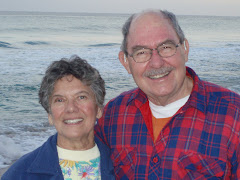We stopped at Grants, NM for a day of sight-seeing. We drove south to El Moro National Monument.
 El Moro is a tall sandstone cuesta, a long rock formation - with an uphill slope, ending in a sharp drop-off at one end of cliffs that are perhaps 150-200 feet high. At the base of El Moro there's a nice pool of water, about100 feet in diameter, that never dries up. For this reason travelers, over the years have stopped here to get watter, and rest. this is really an oasis in very dry high desert.
El Moro is a tall sandstone cuesta, a long rock formation - with an uphill slope, ending in a sharp drop-off at one end of cliffs that are perhaps 150-200 feet high. At the base of El Moro there's a nice pool of water, about100 feet in diameter, that never dries up. For this reason travelers, over the years have stopped here to get watter, and rest. this is really an oasis in very dry high desert.
 El Moro is a tall sandstone cuesta, a long rock formation - with an uphill slope, ending in a sharp drop-off at one end of cliffs that are perhaps 150-200 feet high. At the base of El Moro there's a nice pool of water, about100 feet in diameter, that never dries up. For this reason travelers, over the years have stopped here to get watter, and rest. this is really an oasis in very dry high desert.
El Moro is a tall sandstone cuesta, a long rock formation - with an uphill slope, ending in a sharp drop-off at one end of cliffs that are perhaps 150-200 feet high. At the base of El Moro there's a nice pool of water, about100 feet in diameter, that never dries up. For this reason travelers, over the years have stopped here to get watter, and rest. this is really an oasis in very dry high desert.At the top of El Moro are ruins of an Indian pueblo, that was abandoned around 1400. A small part of the ruins have been reconstructed, as shown in the accompanying photograph. The inhabitants of this structure are thought to be precursors of the Zuni tribe, who now live in a pueblo about 40 miles from El Moro.
 Since this has been a popular stop for travellers, their are numerous petroglyphs and inscriptions on the cliffs. Some of these are ancient Indian petroglyphs, as well as more recent inscriptions by Spanish Conquistadors, American soldiers before and after the Civil War, and many others. The photograph shows a typical piece of graffiti written in Spanish in 1692.
Since this has been a popular stop for travellers, their are numerous petroglyphs and inscriptions on the cliffs. Some of these are ancient Indian petroglyphs, as well as more recent inscriptions by Spanish Conquistadors, American soldiers before and after the Civil War, and many others. The photograph shows a typical piece of graffiti written in Spanish in 1692.

 Since this has been a popular stop for travellers, their are numerous petroglyphs and inscriptions on the cliffs. Some of these are ancient Indian petroglyphs, as well as more recent inscriptions by Spanish Conquistadors, American soldiers before and after the Civil War, and many others. The photograph shows a typical piece of graffiti written in Spanish in 1692.
Since this has been a popular stop for travellers, their are numerous petroglyphs and inscriptions on the cliffs. Some of these are ancient Indian petroglyphs, as well as more recent inscriptions by Spanish Conquistadors, American soldiers before and after the Civil War, and many others. The photograph shows a typical piece of graffiti written in Spanish in 1692.
On the way back to Grants, we stopped at another El Malpais, Spanish for "badlands", another National Monument. This place is for the most part devoted to volcanic geology. There are vast lava fields deposited over thousands of years, the most recent eruption occurring about 2,000 -3,000 years ago. There are volcano tubes to explore, it that is your wont. We did not spend to much time there, as we find lava fields hard to get walk in, and my balance is to unstable to be exploring caves.
The area around the lava fields and cider cones is interesting and quite striking. One interesting feature is a natural arch, shown in the accompanying photo.
From Grants, we drove on and stayed overnight at the top of Raton pass. This pass is of historic interest, as it was one of the more physically trying part of the Santa Fe trail. It was a beautiful place to spend the night.
Today we are in Longmont, CO, and getting ready to celebrate Memorial Day with out daughter, Debbie.










